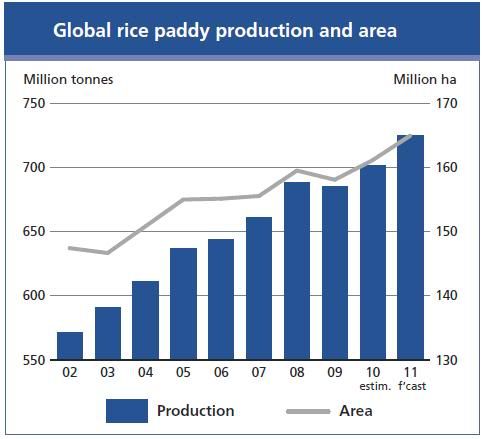
Rice field in Bangladesh
Photo: IFPRI
Looking at this next graph from the FAO, I roughly calculate that the world has increased its rice production by 27%, or 155 million tonnes, in this past decade, while increasing the land area which cultivates rice by 12%, or 18 million hectares. (Increased -reported- crop areas can result from new double cropping.)
Does anyone agree with me that that is quite remarkable?
There are many methods and conditions under which rice, the food which feeds half the world, is grown.
"With the exception of Japan and Korea Rep, rice cultivation in South Asia, Southeast Asia, East Asia, and Africa still uses enormous amounts of human labour, in spite of strikes made in mechanization of rice production. On the other hand, farmers in Europe, America and Australia cultivate large farms and rice cultivation is highly mechanized with large expenditures of energy from fossil fuels."
Factors which have led to increased production these past several decades include dams providing irrigation, underground irrigation, hybrid high-yield rice varieties, and high inputs for some production practices.
The intensification of rice production has harmed the environment and depleted soil nutrients, plus the crop is responsible for a significant amount of greenhouse gas emissions.
What follows in the remainder of this thread are highlights from the recent FAO's rice outlook.——K.M.

- World rice inventories are forecast to rise to their highest level in ten years.
- Under current expectations of vigorous output growth, global production is expected to outpace consumption for the seventh consecutive year.
- As a result, 2012 world rice inventories are expected to rise by 8 percent, or 11 million tonnes, to a decade-high of 148 million tonnes.
- As a result, the world rice stock-to-use ratio, an important indicator of food security, is estimated to reach 31.8 percent in 2012, up from 29.3 percent in 2011.
- Much of the increase in world stocks is likely to be concentrated in China and India, which together are expected to hold close to 70 percent of global reserves.
- Elsewhere, a build up of stocks is expected in Pakistan and Viet Nam, but also in Argentina and Uruguay.
- As a group, the five major exporting countries, namely India, Pakistan, Thailand, the United States and Viet Nam, are anticipated to end the season with a reserve of about 34 million tonnes, compared with 30 million tonnes in 2011.
- Despite heavy floods undermining crop prospects in Southeast Asia, large increases in the top producing countries boost world rice production to a record in 2011.
- Floods are far less of a curse than droughts, for rice growing.
- At the current estimate of 482 million tonnes (723 million tonnes of paddy), world rice production would be 3.4 percent larger than in 2010, reflecting a combination of good weather and attractive prices, which encouraged producers to expand the area under rice by an estimated 2.4 percent to 165 million hectares.
- Average yields are also set to rise by about 1 percent to 2.9 tonnes per hectare (4.38 tonnes, paddy basis).
- The increase in world production is anticipated to be concentrated in Asia, where the five top producing countries, Bangladesh, China, India, Indonesia and Viet Nam, are all heading towards record outputs.
- The FAO forecast for production in Africa has changed little since September, remaining in the order of 17.0 million tonnes, which is 2.6 percent more than in 2010. Much of the increase is expected to originate in Egypt.
- Many western African countries are implementing expansionary rice production policies. In particular, output is set to rise vigorously in Benin, Ghana, Mali, Nigeria and Sierra Leone, amid attractive market prices.
- Full water allocations to rice growers in Australia continued to facilitate a rebound of production to 538 000 tonnes, the highest level since 2006 and four times the volume harvested in 2010.
- The Russian Federation became a net rice exporter in 2011. The country, which has been successful in competing with other medium grain rice suppliers, especially in central Asia and the Near East, is expected to increase its market share in 2012.
- By contrast, in its October rice outlook report, the USDA released a production forecast for the United States of nearly 6 million tonnes, implying a 21 percent decline from 2010 and the lowest performance since 1998. This season’s contraction was driven by a 27 percent decrease in plantings and unfavourable weather conditions in the southern states, which particularly affected the output of long-grain rice varieties.

- Following an 8 percent expansion to an all time high in 2011, a weakening demand may depress international rice trade in 2012.
- FAO anticipates international rice trade to expand by 8 percent in calendar year 2011 to an all time high of 34.0 million tonnes (milled basis).
- Next year, both Bangladesh and Indonesia are anticipated to cut imports amid large domestic supplies.
- Bumper harvests are expected to enable China to halve the size of its purchases in 2012.
- Large supplies are expected to sustain an increase in per capita rice consumption despite prevailing high domestic prices.
- World rice utilization in 2011/12 is forecast to expand by 2.4 percent to 472 million tonnes (milled basis), sustained by an increase in consumption of rice as food, close to 398 million tonnes.
- As for food, the average per capita rice consumption is forecast to approach 57 kg in 2012, about 1 percent more than in 2011.
source: fao
also see: SUSTAINABLE INTENSIFICATION OF RICE PRODUCTION FOR FOOD
SECURITY IN THE NEAR FUTURE [pdf]